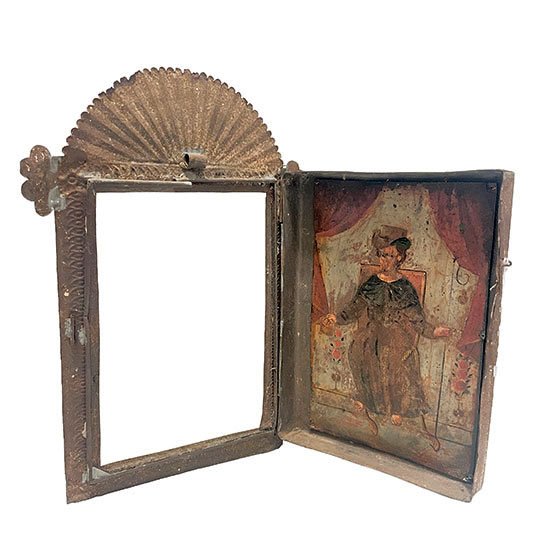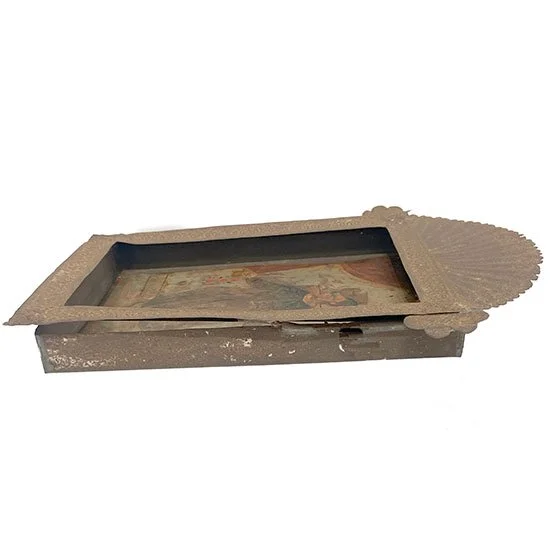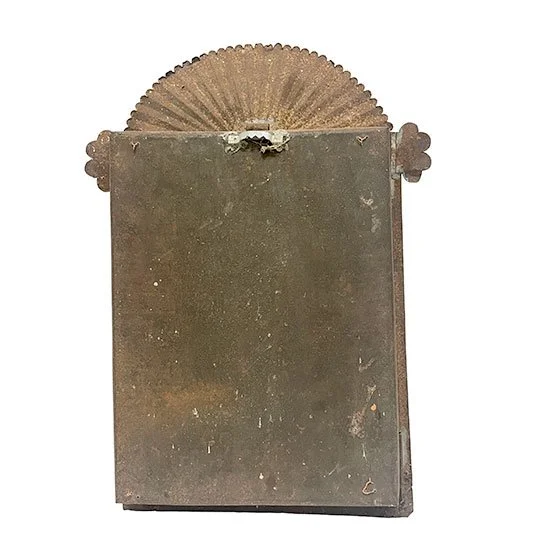 Image 1 of 4
Image 1 of 4

 Image 2 of 4
Image 2 of 4

 Image 3 of 4
Image 3 of 4

 Image 4 of 4
Image 4 of 4





Santo Nino de Atocha Tin Retablo
A Mexican tin nicho with a fine rusty patina embellishes a Spanish Colonial painting on tin of Santo Nino de Atocha. The Nicho has embossed rays on the lunette at the top, and elaborate embossed scrollwork all around the frame and soft floral appendages at the upper corners. The retablo is attached with copper wires to the inside of the attached shallow nicho box.
Santo Nino de Atocha is a representation of the Christ Child, who, dressed as a pilgrim, and barefoot, carries food and water in vessels and containers that are never empty, from which he feeds the hungry. He is the patron saint of children, travelers, miners, and the wrongfully imprisoned.
The frame of the nicho is 10 × 14 inches; the box of the nicho is 8 × 10 ¼ x 1 inches. There is a sliding pin and tube device on the right side to open and close the box, with hinges on the left side. There is a groove inside the door where glass could be installed; a contemporary sawtooth picture hanger is glued to the top of the back. The retablo is missing paint in small areas, but the image still has plenty of clear details of the attributes of Santo Nino. Circa late 19th Century.
A Mexican tin nicho with a fine rusty patina embellishes a Spanish Colonial painting on tin of Santo Nino de Atocha. The Nicho has embossed rays on the lunette at the top, and elaborate embossed scrollwork all around the frame and soft floral appendages at the upper corners. The retablo is attached with copper wires to the inside of the attached shallow nicho box.
Santo Nino de Atocha is a representation of the Christ Child, who, dressed as a pilgrim, and barefoot, carries food and water in vessels and containers that are never empty, from which he feeds the hungry. He is the patron saint of children, travelers, miners, and the wrongfully imprisoned.
The frame of the nicho is 10 × 14 inches; the box of the nicho is 8 × 10 ¼ x 1 inches. There is a sliding pin and tube device on the right side to open and close the box, with hinges on the left side. There is a groove inside the door where glass could be installed; a contemporary sawtooth picture hanger is glued to the top of the back. The retablo is missing paint in small areas, but the image still has plenty of clear details of the attributes of Santo Nino. Circa late 19th Century.
